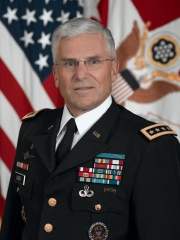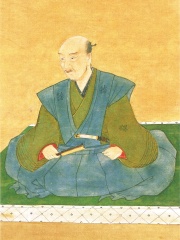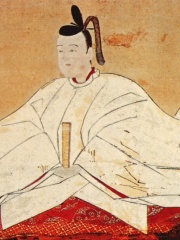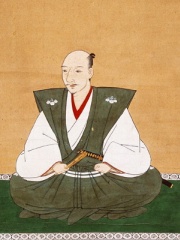
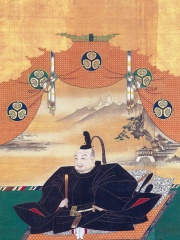
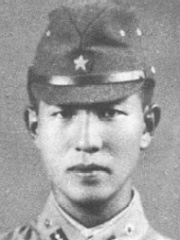
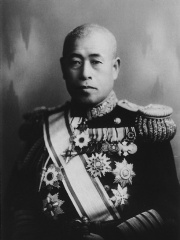
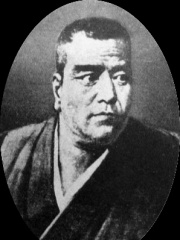
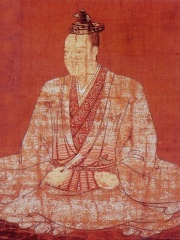
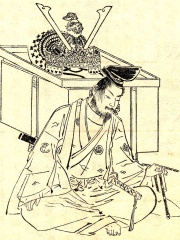
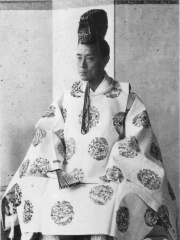
The Most Famous
MILITARY PERSONNELS from Japan
This page contains a list of the greatest Japanese Military Personnels. The pantheon dataset contains 2,058 Military Personnels, 91 of which were born in Japan. This makes Japan the birth place of the 6th most number of Military Personnels behind France, and United Kingdom.
Top 10
The following people are considered by Pantheon to be the top 10 most legendary Japanese Military Personnels of all time. This list of famous Japanese Military Personnels is sorted by HPI (Historical Popularity Index), a metric that aggregates information on a biography's online popularity. Visit the rankings page to view the entire list of Japanese Military Personnels.

1. Oda Nobunaga (1534 - 1582)
With an HPI of 82.89, Oda Nobunaga is the most famous Japanese Military Personnel. His biography has been translated into 75 different languages on wikipedia.
Oda Nobunaga (織田 信長; [o.da (|) no.bɯ(ꜜ).na.ɡa, -na.ŋa] ; 23 June 1534 – 21 June 1582) was a Japanese daimyō and one of the leading figures of the Sengoku and Azuchi-Momoyama periods. He was the Tenka-bito (天下人; lit. 'person under heaven') and regarded as the first "Great Unifier" of Japan. He is sometimes referred as the "Demon Daimyō" and "Demon King of the Sixth Heaven". Nobunaga was an influential figure in Japanese history and is regarded as one of the three great unifiers of Japan, along with his retainers, Toyotomi Hideyoshi and Tokugawa Ieyasu. Nobunaga paved the way for the successful reigns of Hideyoshi and Ieyasu by consolidating power, as head of the very powerful Oda clan, through a series of wars against other daimyō beginning in the 1560s. The period when Nobunaga and Hideyoshi were in power is called the Azuchi–Momoyama period. The name "Azuchi–Momoyama" comes from the fact that Nobunaga's castle, Azuchi Castle, was located in Azuchi, Shiga; while Fushimi Castle, where Hideyoshi lived after his retirement, was located in Momoyama. Nobunaga emerged as the most powerful daimyō, overthrowing the nominally ruling shogun Ashikaga Yoshiaki and dissolving the Ashikaga Shogunate in 1573. He conquered most of Honshu by 1580, and defeated the Ikkō-ikki in the 1580s. Nobunaga's rule was noted for innovative military tactics, fostering of free trade, reforms of Japan's civil government, and the start of the Momoyama historical art period, but also for the brutal suppression of those who refused to cooperate or yield to his demands. Nobunaga committed seppuku during the Honnō-ji Incident in 1582, when his retainer Akechi Mitsuhide ambushed and trapped him in a temple in Kyoto. Nobunaga was succeeded by Toyotomi Hideyoshi, who along with Tokugawa Ieyasu completed his campaign of national unification shortly afterward.

2. Tokugawa Ieyasu (1542 - 1616)
With an HPI of 82.57, Tokugawa Ieyasu is the 2nd most famous Japanese Military Personnel. His biography has been translated into 76 different languages.
Tokugawa Ieyasu (born Matsudaira Takechiyo; January 31, 1543 – June 1, 1616) was a Japanese samurai, daimyo, and the founder and first shōgun of the Tokugawa shogunate of Japan, which ruled from 1603 until the Meiji Restoration in 1868. He was the third of the three "Great Unifiers" of Japan, along with his former lord Oda Nobunaga and fellow Oda subordinate Toyotomi Hideyoshi. The son of a minor daimyo, Ieyasu once lived as a hostage under daimyo Imagawa Yoshimoto on behalf of his father. He later succeeded as daimyo after his father's death, serving as ally, vassal, and general of the Oda clan, and building up his strength under Oda Nobunaga. After Oda Nobunaga's death, Ieyasu was briefly a rival of Toyotomi Hideyoshi, before declaring his allegiance to Toyotomi and fighting on his behalf. Under Toyotomi, Ieyasu was relocated to the Kanto plains in eastern Japan, away from the Toyotomi power base in Osaka. He built his castle in the fishing village of Edo (now Tokyo). He became the most powerful daimyo and the most senior officer under the Toyotomi regime. Ieyasu preserved his strength during Toyotomi's failed attempts to conquer Korea. After Hideyoshi's death and the Battle of Sekigahara, Ieyasu seized power in 1600. He received appointment as shōgun in 1603, and voluntarily resigned from his position in 1605, although he still held the de facto control of government until his death in 1616. He implemented a set of careful rules known as the bakuhan system. This system used precisely graded rewards and punishments to encourage (or compel) the daimyo and samurai to live in peace with each other under the Tokugawa shogunate.

3. Hiroo Onoda (1922 - 2014)
With an HPI of 77.98, Hiroo Onoda is the 3rd most famous Japanese Military Personnel. His biography has been translated into 57 different languages.
Hiroo Onoda (Japanese: 小野田 寛郎, Hepburn: Onoda Hiroo; IPA: [o̞no̞da̠ çiɾo̞ː]) 19 March 1922 – 16 January 2014) was a Japanese soldier who served as a second lieutenant in the Imperial Japanese Army during World War II. One of the last Japanese holdouts, Onoda continued fighting for nearly 29 years after the war's end in 1945, carrying out guerrilla warfare on Lubang Island in the Philippines until 1974. Onoda initially held out with three other soldiers: one surrendered in 1950 and two were killed, one in 1954 and one in 1972. The men did not believe flyers and letters from their families stating that the war was over. They survived on wild fruits, game, and stolen rice, and occasionally engaged in shootouts (using their service rifles) with locals and police. Onoda was contacted in the jungles of Lubang by Japanese adventurer Norio Suzuki in 1974 but still refused to surrender until he was formally relieved of duty by his former commanding officer, Major Yoshimi Taniguchi, who flew from Japan to the island to issue the order. Onoda surrendered on 10 March 1974 and received a hero's welcome when he returned to Japan. That year, he wrote and published a best-selling autobiography and later moved to Brazil, where he became a cattle rancher. In 1984, Onoda returned to Japan, where he died in 2014 at the age of 91.

4. Isoroku Yamamoto (1884 - 1943)
With an HPI of 77.69, Isoroku Yamamoto is the 4th most famous Japanese Military Personnel. His biography has been translated into 64 different languages.
Isoroku Yamamoto (山本 五十六, Yamamoto Isoroku; April 4, 1884 – April 18, 1943) was an admiral of the Imperial Japanese Navy (IJN) and the commander of the Combined Fleet during World War II. He commanded the fleet from 1939 until his death in 1943, overseeing the start of the Pacific War in 1941 and Japan's initial successes and defeats before his plane was shot down by U.S. fighter aircraft over New Guinea. Yamamoto graduated from the Imperial Naval Academy in 1904 and served in the Russo-Japanese War, where he lost two fingers at the Battle of Tsushima. He later studied at Harvard University in the United States and was appointed naval attaché to the Japanese embassy in Washington. His experiences convinced him that naval power depended on access to oil and industrial capacity, and that Japan thus had little hope to defeat the U.S. in a war. He was one of the first naval leaders to conclude that naval aviation and aircraft carriers would play a decisive role in any future conflict. In 1936, Yamamoto was appointed navy vice minister, and opposed Japan's alliance with Germany and Italy in the Tripartite Pact of 1940. In 1939, he was appointed commander-in-chief of the Combined Fleet, and was tasked with creating a strategy for war with the United States; Yamamoto favored a surprise attack, which was carried out at the start of the war with an attack on Pearl Harbor in December 1941. In the early months of the war, the Japanese fleet scored a series of decisive naval victories. These gains were halted at the Battle of Midway in June 1942, in which four Japanese carriers were sunk. Yamamoto committed to the defense of the Solomon Islands in the Guadalcanal campaign, but was unable to prevent their capture. In April 1943, Yamamoto was killed after American code breakers intercepted his flight plans, enabling the United States Army Air Forces to shoot down his aircraft.
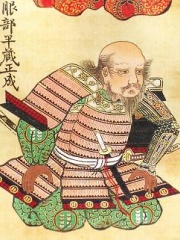
5. Hattori Hanzō (1542 - 1597)
With an HPI of 75.10, Hattori Hanzō is the 5th most famous Japanese Military Personnel. His biography has been translated into 31 different languages.
Hattori Hanzō (服部 半蔵; c. 1542 – January 2, 1597) or Second Hanzō, nicknamed Oni no Hanzō (鬼の半蔵, Demon Hanzō), was a famous samurai of the Sengoku era. He served the Tokugawa clan as a general and is credited with saving the life of Tokugawa Ieyasu, later helping him to become the ruler of united Japan. Hanzō was known as an expert tactician and a master of sword fighting, and was included in cultural sobriquet as one of Tokugawa's 16 divine generals (Tokugawa jūrokushinshō). He became known as the Second Hanzō. He would later earn the nickname Oni no Hanzō (鬼の半蔵, Demon Hanzō) to distinguish him from another Tokugawa general named Watanabe Hanzō (Watanabe Moritsuna), who is nicknamed Yari no Hanzō (槍の半蔵, Spear Hanzō).

6. Saigō Takamori (1828 - 1877)
With an HPI of 74.71, Saigō Takamori is the 6th most famous Japanese Military Personnel. His biography has been translated into 44 different languages.
Saigō Takamori (Japanese: 西郷 隆盛; 23 January 1828 – 24 September 1877) was a Japanese samurai and politician who was one of the most influential figures in Japanese history. He played a key role in the Meiji Restoration, which overthrew the Tokugawa shogunate in 1868, and subsequently served in the new Meiji government. However, he later became disillusioned with the direction of the new regime and led the Satsuma Rebellion against it in 1877, in which he was killed. Born into a low-ranking samurai family in Satsuma Domain, Saigō rose to prominence as a retainer of Shimazu Nariakira, the daimyō of Satsuma. He was involved in national politics in Edo and Kyoto, advocating for shogunal reform and a stronger imperial role. After Nariakira's death, Saigō was exiled twice, first to Amami Ōshima and then to the harsher Okinoerabujima, periods during which he developed his political and philosophical ideas. Pardoned and recalled, he played a crucial part in forging the Satchō Alliance between Satsuma and Chōshū Domain, which was instrumental in the shogunate's downfall during the Boshin War. Saigō commanded imperial forces and negotiated the bloodless surrender of Edo Castle. In the Meiji government, Saigō initially held significant posts, including commander of the Imperial Guard, and was involved in major reforms such as the abolition of the han system. He was a central figure in the caretaker government during the Iwakura Mission. In 1873, he resigned from the government over policy disagreements, particularly the rejection of his proposal for a mission to Korea (Seikanron). Returning to his native Kagoshima, Saigō became the reluctant leader of disaffected samurai who rose against the central government in the Satsuma Rebellion. Despite initial successes, the rebellion was crushed by the numerically and technologically superior Imperial Japanese Army. Saigō died by seppuku after being critically wounded in the final battle at Shiroyama. All of his men were killed in action. Saigō's death cemented his legendary status. He is often referred to as "the last true samurai" and remains a highly popular and romanticized figure in Japan. His life and death have been the subject of numerous books, films, and artistic depictions, reflecting an enduring fascination with his character and his complex role in Japan's transition from feudalism to a modern state. While historical accounts of his actions and motivations vary, Saigō Takamori is widely regarded as a symbol of samurai virtue, sincerity, and tragic heroism.

7. Akechi Mitsuhide (1526 - 1582)
With an HPI of 74.27, Akechi Mitsuhide is the 7th most famous Japanese Military Personnel. His biography has been translated into 32 different languages.
Akechi Mitsuhide (明智 光秀; March 10, 1528 – July 2, 1582), first called Jūbei from his clan and later Koretō Hyūga no Kami (惟任日向守) from his title, was a Japanese samurai general of the Sengoku period. Mitsuhide was originally a bodyguard of the last Ashikaga shōgun Ashikaga Yoshiaki and later, one of the trusted generals under daimyō Oda Nobunaga during his war of political unification in Japan. Mitsuhide rebelled against Nobunaga for unknown reasons in the Honnō-ji Incident in 1582, forcing the unprotected Nobunaga to commit seppuku in Kyoto. Mitsuhide attempted to establish himself as shōgun, but was pursued by Nobunaga's successor Toyotomi Hideyoshi and defeated at the Battle of Yamazaki. The 13-days short reign of Mitsuhide is listed as the inspiration for the yojijukugo set phrase mikkatenka (三日天下; short-lived reign). He is still popular in present culture. A ceremonial activity was held on April 15, 2018, in Kyoto

8. Minamoto no Yoshitsune (1159 - 1189)
With an HPI of 73.68, Minamoto no Yoshitsune is the 8th most famous Japanese Military Personnel. His biography has been translated into 35 different languages.
Minamoto no Yoshitsune (源 義経; Japanese pronunciation: [mʲi.na.mo.to no (|) jo.ɕi̥.tsɯꜜ.ne], c. 1159 – June 15, 1189) was a commander of the Minamoto clan of Japan in the late Heian and early Kamakura periods. He was the younger half-brother of Minamoto no Yoritomo, the first shogun of the Kamakura shogunate, and was the ninth son of his father. His common name was Kurō, and his formal name was Yoshitsune. Born as the ninth son of Minamoto no Yoshitomo of the Kawachi Genji clan, his childhood name was Ushiwakamaru. Due to his father's defeat and death in the Heiji Rebellion, he was entrusted to Kurama-dera temple. He later traveled down to Hiraizumi, where he received the protection of Fujiwara no Hidehira, the head of the Ōshū Fujiwara clan. When his brother Yoritomo raised an army to overthrow the Taira clan (the Jishō-Juei War), Yoshitsune rushed to join him. He became the greatest contributor to the Minamoto victory, destroying the Taira clan through the battles of Ichi-no-Tani, Yashima, and Dan-no-ura. Although Yoritomo and Yoshitsune initially had a close relationship, described as being like "father and son," Yoshitsune incurred Yoritomo's wrath by accepting court titles without permission and acting independently during the war against the Taira. When Yoshitsune showed signs of seeking his own independence in response, he came into conflict with Yoritomo and was declared an enemy of the court. After an order for his capture was issued nationwide, he fled and once again sought refuge with Fujiwara no Hidehira. However, after Hidehira's death, Hidehira's successor, Fujiwara no Yasuhira, under pressure from Yoritomo, attacked Yoshitsune. He was forced to commit suicide at the Koromogawa-no-tachi mansion in what is now Hiraizumi, Iwate Prefecture. He is considered one of the greatest and the most popular warriors of his era, and one of the most famous samurai in the history of Japan. Later labelled as a tragic hero, his dramatic end drew great sympathy from the public, giving rise to the term hōganbiiki (sympathy for the underdog, from one of Yoshitsune's titles, Hōgan), as well as numerous legends and stories.

9. Tokugawa Yoshinobu (1837 - 1913)
With an HPI of 72.80, Tokugawa Yoshinobu is the 9th most famous Japanese Military Personnel. His biography has been translated into 43 different languages.
Prince Yoshinobu Tokugawa (德川 慶喜, Tokugawa Yoshinobu; 28 October 1837 – 22 November 1913) was a Japanese samurai, daimyo and the 15th and last shōgun of the Tokugawa shogunate of Japan. He was part of a movement which aimed to reform the aging shogunate, but was ultimately unsuccessful. He resigned his position as shogun in late 1867, while aiming at keeping some political influence. After these efforts failed following the defeat at the Battle of Toba–Fushimi in early 1868, he went into retirement, and largely avoided the public eye for the rest of his life.
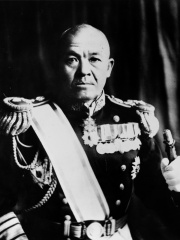
10. Chūichi Nagumo (1887 - 1944)
With an HPI of 72.18, Chūichi Nagumo is the 10th most famous Japanese Military Personnel. His biography has been translated into 40 different languages.
Chūichi Nagumo (南雲 忠一, Nagumo Chūichi; 25 March 1887 – 6 July 1944) was an admiral in the Imperial Japanese Navy (IJN) during World War II. Nagumo led Japan's main carrier battle group, the Kido Butai, in the attack on Pearl Harbor in 1941, and over the next months in successful raids on Darwin in Australia and in the Indian Ocean. In June 1942, he participated at the Battle of Midway, where his strike force suffered a crushing defeat. Nagumo was re-assigned to another fleet during the Guadalcanal campaign, and later stationed in the Japanese home islands. In 1944, he was deployed to a naval command in the Mariana Islands, where he committed suicide during the Battle of Saipan.
People
Pantheon has 91 people classified as Japanese military personnels born between 758 and 1948. Of these 91, 1 (1.10%) of them are still alive today. The most famous living Japanese military personnels include George W. Casey Jr.. The most famous deceased Japanese military personnels include Oda Nobunaga, Tokugawa Ieyasu, and Hiroo Onoda.
Living Japanese Military Personnels
Go to all RankingsDeceased Japanese Military Personnels
Go to all RankingsOda Nobunaga
1534 - 1582
HPI: 82.89
Tokugawa Ieyasu
1542 - 1616
HPI: 82.57
Hiroo Onoda
1922 - 2014
HPI: 77.98
Isoroku Yamamoto
1884 - 1943
HPI: 77.69
Hattori Hanzō
1542 - 1597
HPI: 75.10
Saigō Takamori
1828 - 1877
HPI: 74.71
Akechi Mitsuhide
1526 - 1582
HPI: 74.27
Minamoto no Yoshitsune
1159 - 1189
HPI: 73.68
Tokugawa Yoshinobu
1837 - 1913
HPI: 72.80
Chūichi Nagumo
1887 - 1944
HPI: 72.18
Ishida Mitsunari
1559 - 1600
HPI: 71.42
Toyotomi Hideyori
1593 - 1615
HPI: 71.30
Overlapping Lives
Which Military Personnels were alive at the same time? This visualization shows the lifespans of the 25 most globally memorable Military Personnels since 1700.

